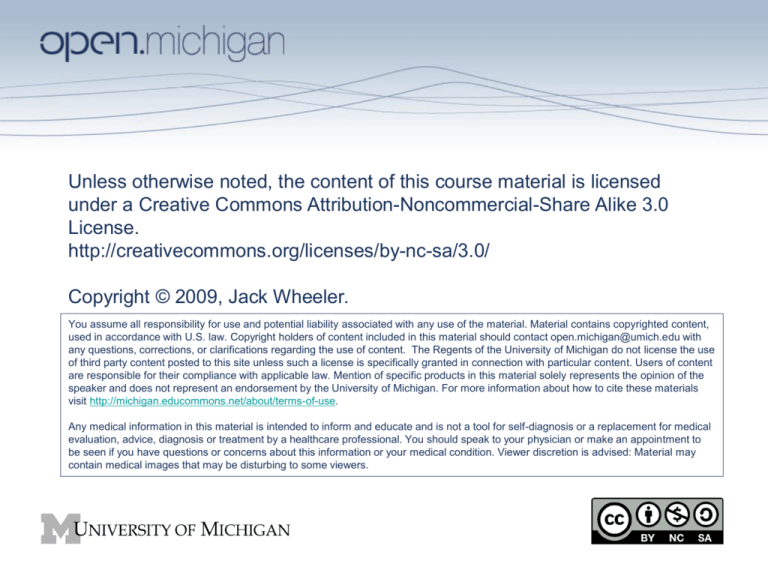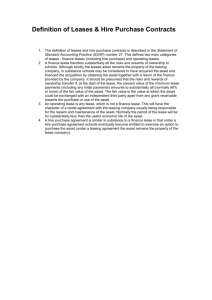lectures-1/HMP607-F08-Lecture19 - Open.Michigan
advertisement

Unless otherwise noted, the content of this course material is licensed under a Creative Commons Attribution-Noncommercial-Share Alike 3.0 License. http://creativecommons.org/licenses/by-nc-sa/3.0/ Copyright © 2009, Jack Wheeler. You assume all responsibility for use and potential liability associated with any use of the material. Material contains copyrighted content, used in accordance with U.S. law. Copyright holders of content included in this material should contact open.michigan@umich.edu with any questions, corrections, or clarifications regarding the use of content. The Regents of the University of Michigan do not license the use of third party content posted to this site unless such a license is specifically granted in connection with particular content. Users of content are responsible for their compliance with applicable law. Mention of specific products in this material solely represents the opinion of the speaker and does not represent an endorsement by the University of Michigan. For more information about how to cite these materials visit http://michigan.educommons.net/about/terms-of-use. Any medical information in this material is intended to inform and educate and is not a tool for self-diagnosis or a replacement for medical evaluation, advice, diagnosis or treatment by a healthcare professional. You should speak to your physician or make an appointment to be seen if you have questions or concerns about this information or your medical condition. Viewer discretion is advised: Material may contain medical images that may be disturbing to some viewers. Lease Financing • • • • • • • Lease Financing Defined Reasons to Consider Leasing Financial v. Operating Leases Accounting Treatment of Leases Lease Contract Valuing Financial Leases Leasing and Adjusted Present Value Lease Financing Defined • Means by which firm can acquire use of an asset for period of time without purchasing asset outright • Rental agreement extending for year or more and involving series of fixed payments • One of three basic financing methods – Purchase with equity – Borrow and purchase – Lease – viewed by financial markets as form of debt Reasons to Consider Leasing (valid) • May be lower interest rate • May be income tax advantage (or other subsidy) • Way to avoid risk of technological change • Way to avoid transactions costs associated with buying and selling • Way to avoid restrictions (covenants) of debt financing • Maintenance costs may be included Reasons to Consider Leasing (specious) • Way to improve balance sheet – off-balance-sheet-financing is limited by accounting rules and unlikely to fool many • Way to conserve capital – borrowing does, too • Way to avoid expenditure controls – Internal – External Financial v. Operating Leases Financial: Noncancelable contractual commitment on part of lessee to make series of payments to lessor for use of asset, and one of the following applies: • Lease transfers title to lessee before lease expires • Lease has option to purchase at bargain • Lease period exceeds 75 percent of asset life • PV of lease payments exceeds 90 percent of value If these conditions met, most of economic value of asset transferred to lessee Operating: Cancelable at option of lessee or none of the above conditions holds. Most of economic value retained by lessor Accounting Treatment of Leases • Financial (Capital) Leases – Leased asset reported as fixed asset – PV of future lease payments reported as liability - “Obligations Under Capital Leases” • Operating Leases – Footnote disclosure Lease Contract • Basic lease period (not cancelable) • Timing and amounts of payments during blp • Option to renew lease or purchase asset at end of blp • Provision for payment of cost of maintenance, repairs, taxes, insurance, utilities, etc. – Net - lessee pays – Full Service or Rental - lessor pays Valuing Financial Leases What: Compare financing provided by lease to financing provided by equivalent loan Why: Leasing is commitment for fixed payments similar to debt How: Discount lease cash flows at net after-tax (and other subsidies) interest rate firm would pay on equivalent loan NPV = Initial Financing Provided + (LCFt)/(1-rD)t where LCF = - lease pmt + tax shield of lease pmt - depn tax shield lost Net interest rate Valuing Financial Leases Example Asset cost = $200,000 T = 10 years No salvage value Lease payment = $27,000 (pd at beginning of yr) Debt int rate = .10 mtr = .3 (effect is at end of year) No difference in operating costs Leasing and Adjusted Present Value Some Rules: 1. Keep financing and investment analyses separate 2. When financing and investment decisions interact, the analysis needs to reflect the effect on value of both the investment and financing aspects of the decision APV = basic (investment) NPV + NPV of financing caused by project Leasing and Adjusted Present Value • Positive NPV of lease means if you acquire asset lease financing is advantageous (less costly than debt financing) • It does not, however, mean you should acquire asset • In general, asset acquisition depends on (investment) NPV of project • But favorable lease terms can sometimes rescue negative NPV project by creating a positive APV Leasing and Adjusted Present Value Example • • • • Assume the NPV of acquiring the asset in the previous example, employing your firm’s overall cost of capital of .09 (after tax) was determined to be -$3000. You therefore should tentatively make the decision not to purchase it. If, however, the seller offers to lease the asset to you at the terms in the example, which imply a lower cost of financing (again after tax) than your typical interest rate Then, the whole activity takes on a positive APV: APV = NPV of project + NPV of lease = -$3000 + $11,838 = $8838



